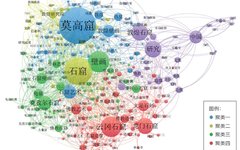Originally published in “Research on Nature and Cultural Heritage”, 2022, Issue 3
Characterization Analysis of the Knowledge Graph on Chinese Grottoes Research
(Excerpts)
LIU Yingnan1, ZHAN Changfa2*, ZHANG Xiangqian1, XI Yanfeng1, XIN Taiqi1
(1. Beijing Digsur Science and Technology Co., Ltd., Beijing 100012; 2. Southern Marine Science and Engineering Guangdong Laboratory (Zhuhai), Zhuhai Guangdong 519080)
Abstract: Cave temples are an important carrier of China’s religious history, religious art, and social culture, embodying the values, cultural spirit, and aesthetic pursuits of the Chinese nation. This article selects data from CNKI to systematically characterize and analyze the knowledge hotspots, evolution processes, and development trends of grotto temple research in China from 1990 to 2020 across five aspects: archaeology and history, safety and management, protection and technology, preventive conservation, and display and utilization. Additionally, the article selects WoS data to analyze knowledge hotspots related to grotto research in the international cultural heritage field from 1998 to 2021, aiming to provide a certain cognitive and interpretative basis for grotto research.
Keywords: China; cave temples; research; knowledge graph
Classification Number: G122 Document Identification Code: A
DOI: 10.19490/j.cnki.issn2096-698X.2022.03.044-063
1 Data Sources and Research Methods
1.1 Data Sources
The data for this article comes from 7,049 Chinese journal papers published in the “China Academic Journal Network Publishing Database” from January 1, 1990, to December 31, 2020; 722 papers from the “China Excellent Master’s and Doctoral Dissertations Full-text Database”; 422 papers from the “China Important Conference Papers Full-text Database”; and 1,805 books from the “China Book Bibliography Database”.
1.2 Research Methods
The knowledge graph focuses on the knowledge domain and visually presents the development process and structural relationships of scientific knowledge. This article utilizes SQLServer database for data extraction and processing, and applies software such as Python, Gephi, and VOSviewer for the visualization and analysis of knowledge graphs related to Chinese grotto research.
2 Knowledge Graph Characterization Analysis
Based on literature review analysis, Chinese grotto research mainly involves five aspects: archaeology and history, safety and management, protection and technology, preventive conservation, and display and utilization. Among them: the archaeology and history aspect mainly conducts research on grotto archaeology and religious history, art history, and social history; the safety and management aspect mainly focuses on grotto safety protection and comprehensive management research; the protection and technology aspect mainly concerns the analysis of grotto diseases; the preventive conservation aspect primarily reflects the dynamic monitoring of related factors of cultural relics in the areas where grottoes are located or the surface of grottoes; and the display and utilization aspect mainly conducts research on grotto cultural dissemination and public services.
2.1 Archaeology and History Analysis
From 1990 to 2020, the publication volume in the archaeology and history aspect rapidly increased to 7,038 papers, including 1,047 funded papers and 1,886 papers indexed by core journals, with a total citation frequency reaching 44,466 times, containing 13,736 keywords. Among them, from 2001 to 2010, the attention on archaeology and history increased, with the publication volume doubling compared to the previous decade, and the quality and academic influence of funded papers improved; from 2011 to 2020, archaeology and history entered a rapid development stage, with the annual publication volume significantly increasing (peaking at 476 papers in 2019), and the quality of papers significantly improved, while the citation frequency decreased considerably (starting from 2017, the downward trend of citation frequency became increasingly obvious, with 600 times in 2017, 407 times in 2018, 268 times in 2019, and 35 times in 2020). To outline the developmental characteristics and knowledge hotspot evolution of the archaeology and history dimension, keyword co-occurrence network analysis was conducted using VOSviewer software, taking the period from 2016 to 2020 (Figure 1) as an example, with a threshold of 5. The size of the nodes represents the degree of keyword co-occurrence (the more co-occurrences, the larger the node).
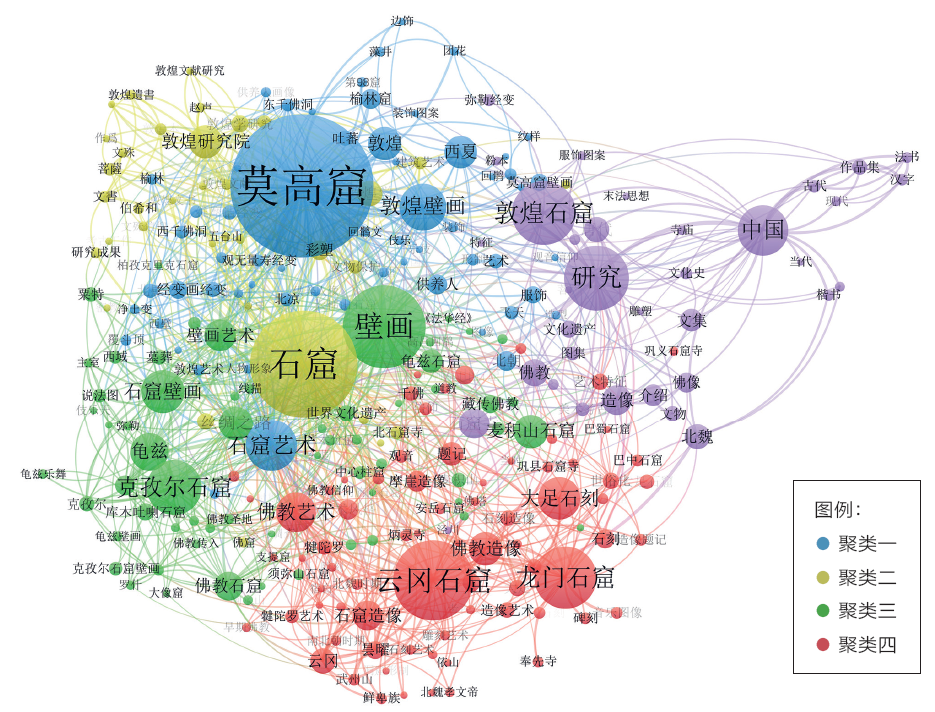
Note: Threshold is 5; 268 keywords.
Figure 1 Keyword co-occurrence map in archaeology and history from 2016 to 2020 (Source: drawn by the author)
Through visualization representation, it can be seen that the archaeology and history aspect focuses on foundational theories such as archaeology, history, and aesthetics, engaging in comprehensive research on religion, historical art, and society, exploring the thematic content, Buddhist thought, nature, function, artistic characteristics, and sources of caves, as well as traditional materials and techniques, enriching the research results and cultural cognition of grottoes, thereby laying a solid historical and cultural value foundation for grotto temple research. Through the knowledge graph characterization analysis, it can be seen that the research results mainly focus on regional studies of grotto temples. With the release of the “Guiding Opinions of the General Office of the State Council on Strengthening the Protection and Utilization of Grotto Temples” (2020), “establishing and improving the archaeological research system of Chinese grotto temples” and “deepening academic research and value excavation” will become the research trend in the next stage.
2.2 Protection and Technology Analysis
From 1990 to 2020, the publication volume in the protection and technology aspect was 823 papers, including 229 funded papers and 303 papers indexed by core journals, with a total citation frequency reaching 5,471 times, containing 2,197 keywords. Among them: from 2001 to 2010, the attention to protection and technology increased; from 2011 to 2020, the annual publication volume grew, and the quality of papers in this stage improved, while the citation frequency saw a significant decline (especially after 2017, the downward trend of citation frequency became increasingly significant, with 65 times in 2017, 103 times in 2018, 16 times in 2019, and 2 times in 2020). To outline the developmental characteristics and knowledge hotspot evolution of the protection and technology aspect, keyword co-occurrence network analysis was conducted using VOSviewer software, taking the period from 2011 to 2020 (Figure 2) as an example, with a keyword co-occurrence threshold of 2.
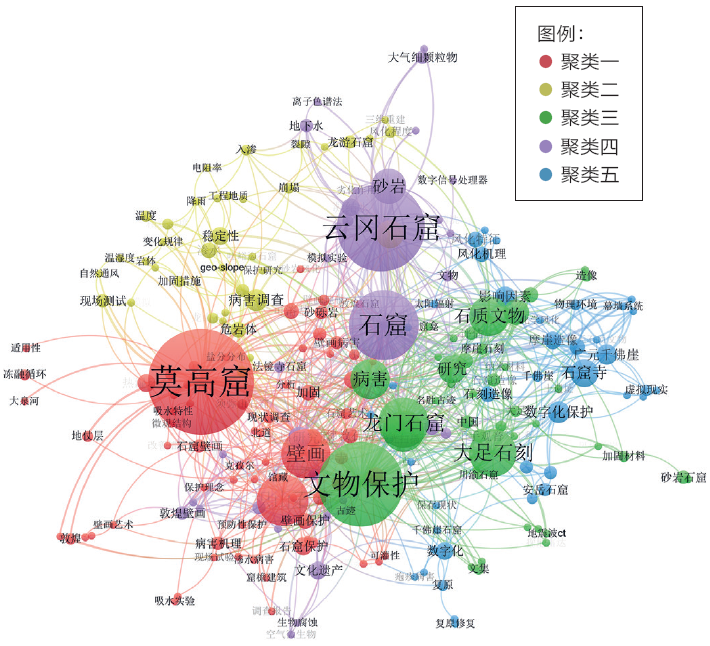
Note: Threshold is 2; 237 keywords.
Figure 2 Keyword co-occurrence map in protection and technology from 2011 to 2020 (Source: drawn by the author)
Through visualization representation, it can be seen that the research in the protection and technology aspect is based on the objects such as cultural relics themselves and their environment, as well as major diseases, such as weathering (including biological diseases), water damage, and instability, based on the formation mechanisms, influencing factors, material and structural differences of these diseases, engaging in research on protection and restoration as well as the application of new technologies, new materials, and new methods, with theoretical foundations from geology, civil engineering (geotechnical engineering, structural engineering, disaster prevention and reduction engineering, and protection engineering), architecture, materials science, and engineering. The research results in this aspect mainly focus on rock mass stability, diseases of stone carvings and murals, and protective materials, preserving the authenticity and integrity of cultural relics while presenting their scientific value. With the continuous development of technological means, “deepening research on disease development mechanisms”, “integration of digital technology and protection restoration”, and “promoting the establishment of a protection technology integration system and systematic solutions” will become the research trends in the next stage.
2.3 Safety and Management Analysis
From 1991 to 2020, the publication volume in the safety and management aspect was 182 papers, including 27 funded papers and 40 papers indexed by core journals, with a total citation frequency of 476 times, containing 731 keywords. Among them: from 2011 to 2020, the annual publication volume increased, ranging between 5 to 19 papers (peaking at 19 papers in 2016), with a cumulative publication volume of 114 papers, including 23 funded papers and 14 papers indexed by core journals, with a total citation frequency of 244 times. Using VOSviewer software for keyword co-occurrence network analysis (with a keyword co-occurrence threshold of 3), three major clusters of keyword co-occurrence networks were presented, represented by different colors (Figure 3).
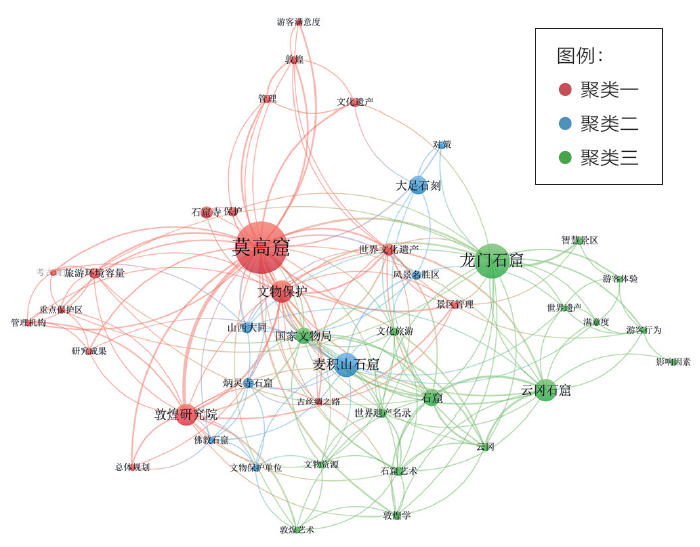
Figure 3 Keyword co-occurrence network in safety and management (Source: drawn by the author)
Through visualization representation, it can be seen that the research in the safety and management aspect mainly revolves around safety management, visitor management, and operational management, exploring issues such as human destruction, tourism management, visitor load, management models, and overall planning, taking corresponding comprehensive measures in various technologies and management to slow down the destruction caused by various natural forces to grotto temples and to prevent human damage and destruction during their open utilization. The research results in this dimension mainly focus on tourism environmental capacity, scenic area development management, visitor experience, and satisfaction. Under the requirement of “promoting the modernization of the national governance system and governance capacity”, the safety and comprehensive management of grotto temples, including “establishing a long-term mechanism for safety management of grotto temples”, “building a comprehensive control system for information management and safety protection of grotto temples”, and “regulating tourism development activities and guiding visiting activities”, will become the research trends in the next stage.
2.4 Preventive Conservation Analysis
From 1990 to 2020, the publication volume in the preventive conservation aspect was 125 papers, including 56 funded papers and 57 papers indexed by core journals, with a total citation frequency reaching 785 times, containing 401 keywords. Among them: from 2011 to 2020, the publication volume increased, ranging from 2 to 13 papers, with a cumulative publication volume of 73 papers (peaking at 13 papers in 2018), including 29 funded papers and 24 papers indexed by core journals, with a total citation frequency of 171 times. Using VOSviewer software for keyword co-occurrence network analysis (with a keyword co-occurrence threshold of 2), five major clusters of keyword co-occurrence networks were presented, represented by different colors (Figure 4).
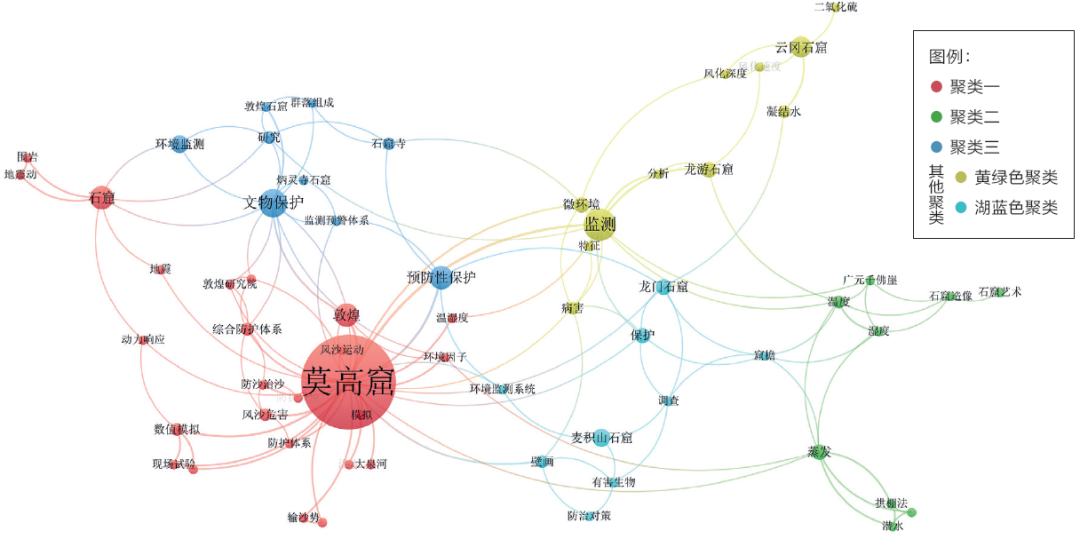
Figure 4 Keyword co-occurrence network in preventive conservation (Source: drawn by the author)
Through visualization representation, it can be seen that research in the preventive conservation aspect mainly focuses on disaster warning and prevention, monitoring and early warning, risk assessment methods, and mechanisms of structural and material damage, involving related technologies and methods, and the research and development of professional tools and software. By taking corresponding preventive measures against potential damage or deterioration, the research aims to prolong the lifespan of grotto relics, extend the period of protection and reinforcement of relics, and reduce or mitigate the impact of various factors on the value of cultural relics. The research results in this aspect mainly focus on the pathways and countermeasures for preventing damage from sandstorms and floods, monitoring and simulating the overall environment of grottoes, as well as monitoring and early warning systems for microenvironments inside the caves and external environments, and countermeasures and protective systems for diseases of statues and murals. Given the severe situation caused by natural disasters and human factors affecting the safety of grotto temples in recent years, establishing a health assessment system for grotto temples, building a risk monitoring and assessment system for grotto temples, and constructing a multi-source heterogeneous database for risk management and preventive protection will become the research trends in the next stage.
2.5 Display and Utilization Analysis
2.5.1 Overall Research Overview
From 1990 to 2020, the publication volume in the display and utilization aspect was 1,830 papers, including 73 funded papers and 179 papers indexed by core journals, with a total citation frequency reaching 2,788 times, containing 5,447 keywords. Among them: from 2011 to 2020, this aspect experienced rapid development, with significant annual publication growth, ranging from 39 to 205 papers, with a cumulative publication volume of 1,070 papers (peaking at 205 papers in 2019), including 67 funded papers and 68 papers indexed by core journals, with a total citation frequency of 690 times. Using VOSviewer software for keyword co-occurrence network analysis (with a keyword co-occurrence threshold of 15), four major clusters of keyword co-occurrence networks were presented, represented by different colors (Figure 5).
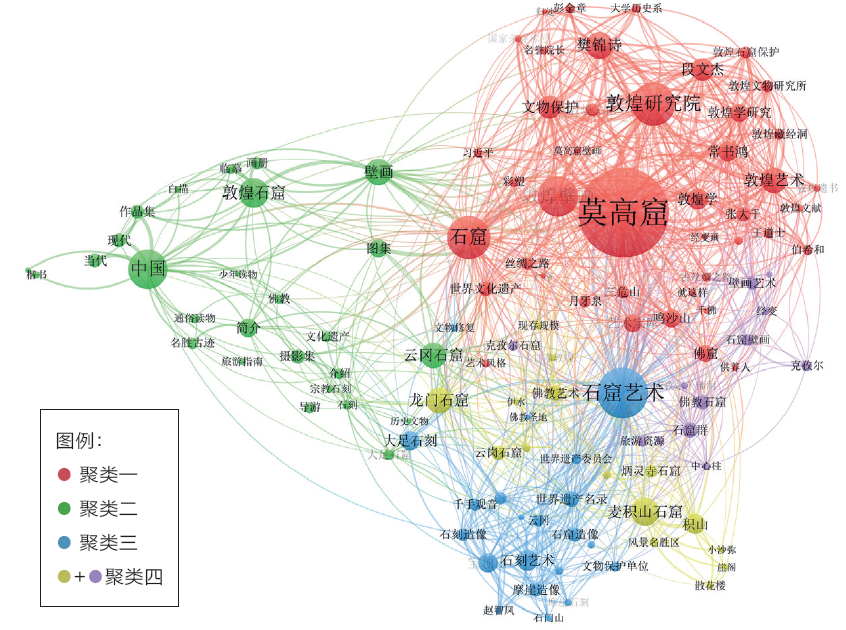
Figure 5 Keyword co-occurrence network in display and utilization (Source: drawn by the author)
Through visualization representation, it can be seen that the display and utilization aspect, based on protection, focuses on the dissemination of grotto culture and values, conducting multi-dimensional, rich, and reasonable dissemination and exhibition (traditional and digital) forms, enhancing cultural creativity, and professional interpretation, promoting and disseminating traditional culture, meeting public spiritual and cultural aesthetic needs, and improving public awareness of the value of grotto temples, gradually moving towards public participation in education and the construction of socialist core values, participating in global civilization dialogue. The research results in this dimension mainly focus on cultural displays and promotions in formats such as photography collections and albums, experiences and spiritual promotion from conservation staff, applications of multimedia information technology, digital educational resources, tourism interpretation systems, and tourism cultural and creative products, aiming to realize the social and cultural value of grotto temples. Based on the contemporary demand to “revitalize cultural relics” and expand the influence of Chinese culture, promoting the value of Chinese grotto art and aesthetic value, “enhancing the comprehensive display of grotto temples”, “building cultural heritage routes for grotto temples”, and “promoting academic and cultural exchanges of grotto temples” will become the research trends in the next stage.
2.6 International Perspective Analysis Based on WoS Data
The international perspective data comes from the WoS database core collection from 1900 to 2021, mainly including journals from the SCI, SSCI, AHCI, and ESCI databases, as well as conference papers from CPCI-S and CPCI-SSH, and book databases from BKCI-S and BKCI-SSH, with the search theme being “grotto” or “grottoes”, totaling 714 papers. Before 1997, the annual publication volume ranged from 1 to 5 papers, with a cumulative volume of 55 papers; from 1998 to 2014, it ranged from 9 to 37 papers annually, with a cumulative volume of 307 papers; from 2015 to 2021, it ranged from 46 to 63 papers annually (peaking at 63 papers in 2019), with a cumulative volume of 351 papers. The publication statistics of domestic and foreign experts and scholars were analyzed from the following three aspects.
First, the analysis of domestic experts and scholars’ publication statistics (total of 246 papers). Using VOSviewer software for visual analysis of 246 papers, with a threshold set to 2, a total of 108 keywords co-occurred. Figure 6 shows the co-occurrence of 77 effective keywords, presenting four major clusters of keyword co-occurrence networks. Through visualization representation, it can be seen that: Cluster one focuses on relative humidity, wind speed, sedimentary structures, seismic responses, etc., of grotto environments, conducting dynamic characteristic analysis through numerical simulation and hierarchical analysis methods for cultural heritage protection, as well as showcasing grotto art through technologies such as three-dimensional laser scanning and 3D printing; Cluster two focuses on grotto murals, conducting mural research through three-dimensional reconstruction, digitization, texture mapping, and image segmentation techniques, analyzing mural pigments using Raman spectroscopy, and studying grotto microenvironments through perspectives of air biology using immunofluorescence microscopy and enzyme-linked immunosorbent assays; Cluster three focuses on grotto temperature, humidity, water, air fungi, bacterial communities, and fungal communities, exploring suitable environments for relic preservation; Cluster four focuses on moisture and salt in stone relics, studying related diseases caused by them.
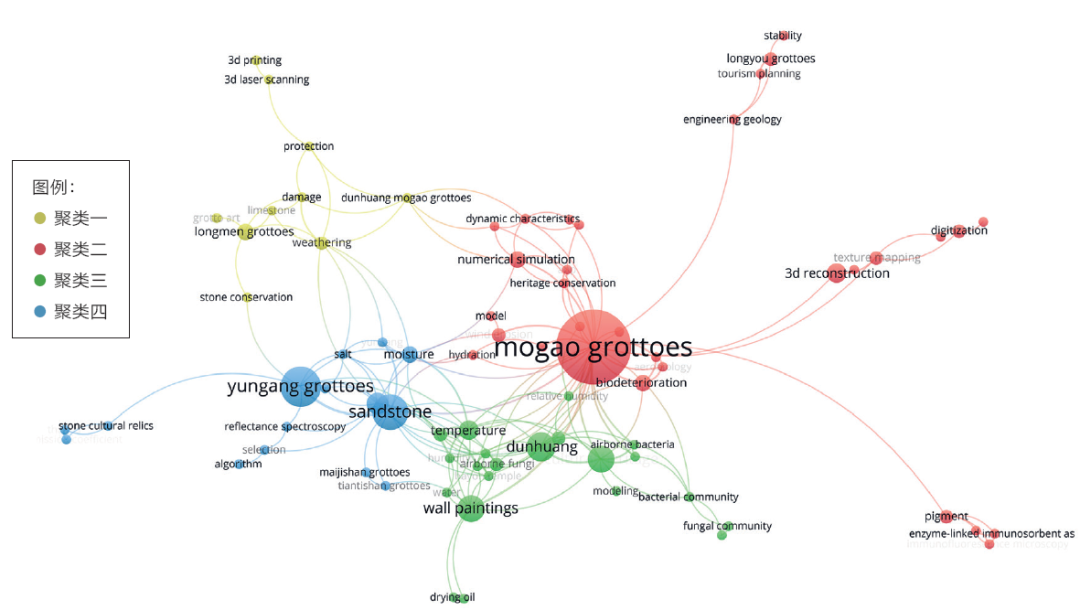
Figure 6 Keyword co-occurrence network of domestic experts and scholars (total of 77 keywords) (Source: drawn by the author)
Secondly, the analysis of foreign experts and scholars’ publication statistics (total of 289 papers). Using VOSviewer software for visual analysis of 289 papers, with a threshold set to 1, a total of 105 keywords co-occurred. Figure 7 shows the co-occurrence of 55 effective keywords, presenting four major clusters of keyword co-occurrence networks. Through visualization representation, it can be seen that: Cluster one studies Neanderthals and Homo sapiens in regions such as Central Asia, the Bahamas, the Caucasus, North Caucasus, China, and Uzbekistan during the Middle Paleolithic, Pleistocene, and Old Stone Age from an archaeological perspective; Cluster two studies the impact of bacteria and fungi on the biodiversity of lungless salamanders, grotto salamanders, and trematodes in environments such as karst landforms and cave deposits during winter shelters from an air biology perspective; Cluster three conducts research on the protection of cultural heritage in regions such as the Juan de Fuca Ridge, mid-ocean ridge, Pacific, and Sicily, mainly focusing on thermal conduction, heat transfer, and hydrothermal fields; Cluster four conducts research on ancient climates and Neanderthals in regions such as the Urals and South Africa from geochemistry, geomorphology, and geological chronology perspectives.
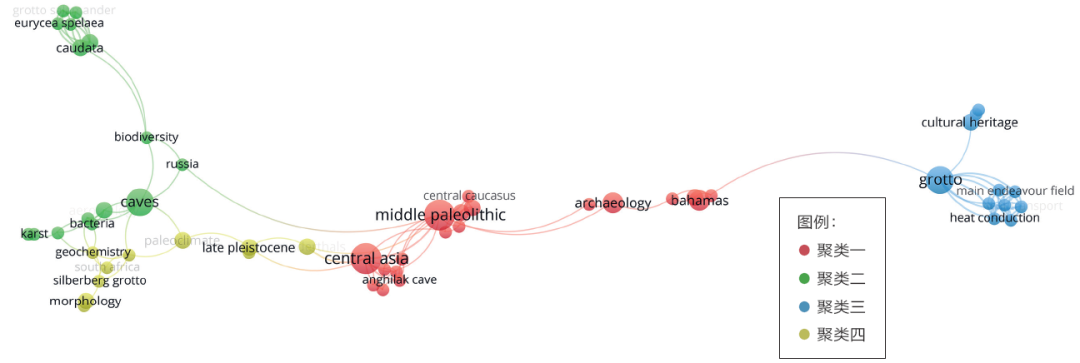
Figure 7 Keyword co-occurrence network of foreign experts and scholars (total of 55 keywords) (Source: drawn by the author)
Finally, the analysis of collaborative publication statistics of domestic and foreign experts and scholars (total of 45 papers). Using VOSviewer software for visual analysis of 45 papers, with a threshold set to 1, a total of 199 keywords co-occurred. Figure 8 shows the co-occurrence of 49 effective keywords, presenting four major clusters of keyword co-occurrence networks. Through visualization representation, it can be seen that: Cluster one analyzes the pigments of grotto murals and colored relics using instruments such as pygc/ms, infrared spectrometers, Raman microscopes, and scanning electron microscopes, as well as the study of adhesives, drying oils, and tung oil; Cluster two uses church murals and sculptures as objects, employing microscopes and Raman microscopes for spectral and emission spectral analysis and identification; Cluster three explores the impact of human activities and agricultural production on the environment during the Anthropocene from the perspectives of paleobotany and paleoclimatology, using Bayesian modeling; Cluster four conducts x-ray diffraction and neutron activation analysis of limestone from a geochemical perspective.

Figure 8 Collaborative publication keyword co-occurrence network of domestic and foreign experts and scholars (total of 49 keywords) (Source: drawn by the author)
3 Conclusion
This article systematically presents the knowledge evolution process and current status of grotto-related research through knowledge graph tools and methods in a panoramic and visual manner.
Looking ahead, it is crucial to reveal the irreplaceable cultural resource attributes of Chinese grottoes, accurately extract and showcase the spiritual identifiers of excellent Chinese traditional culture, and construct a cultural interpretation system of Chinese grottoes based on the objects of grotto bodies, carriers, and cultural relics environments, with historical sequences (temporal dimensions) and regional contexts (spatial dimensions) as axes, and archaeology and history, protection and technology, safety and management, preventive conservation, and display and utilization as functional layers, to comprehensively express the cultural value and contemporary significance of grottoes in modern society, “upholding the direction of sinicization of religion in China, actively guiding religion to adapt to socialist society and the new era of socialism with Chinese characteristics”, inheriting the history of Chinese culture.
① Publication volume: refers to the total number of papers published in journals by a certain discipline, year, author, institution, or region, reflecting the research output capacity, which is a manifestation of its research technical level and comprehensive strength.
② Funded papers: articles funded by grants.
③ Citation frequency: refers to the number of times papers published in journals by a certain discipline, year, author, institution, or region are cited by journal papers, conference papers, doctoral dissertations, and master’s theses, reflecting the research influence, which is a manifestation of the strength and level of research papers.
References

Author Information: LIU Yingnan (1982—), female, postdoctoral, doctor, main research direction is cultural heritage interpretation. E-mail:[email protected].
*Corresponding Author: ZHAN Changfa (1956—), male, second-level research librarian, main research direction is cultural heritage protection and research. E-mail:[email protected].
